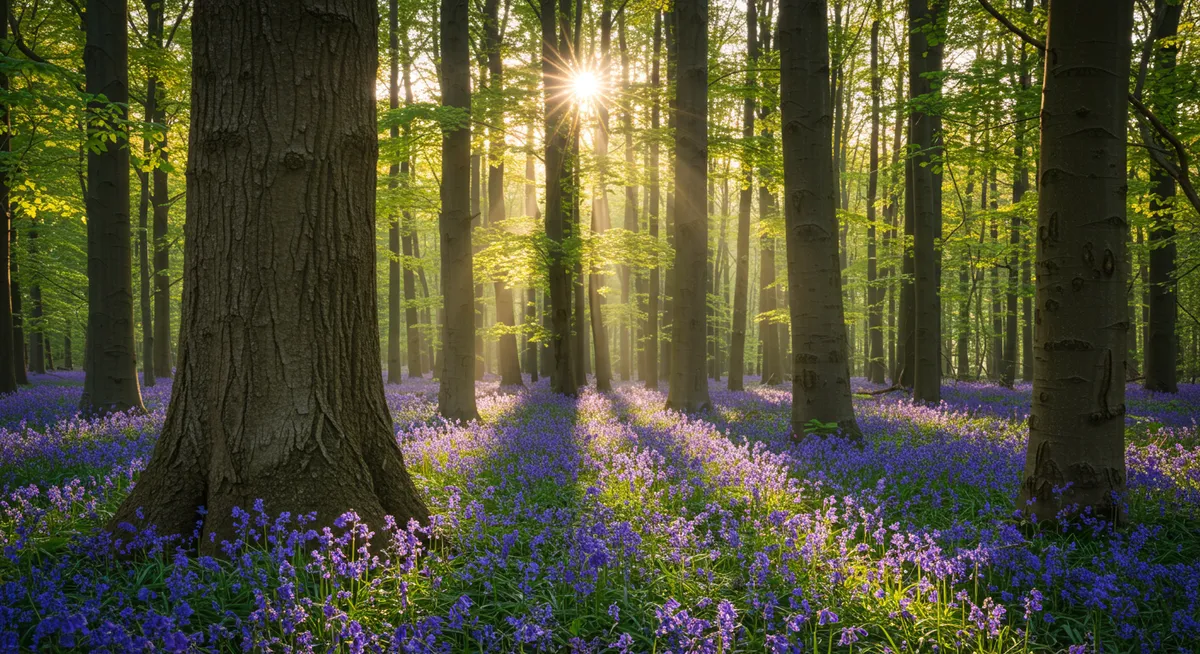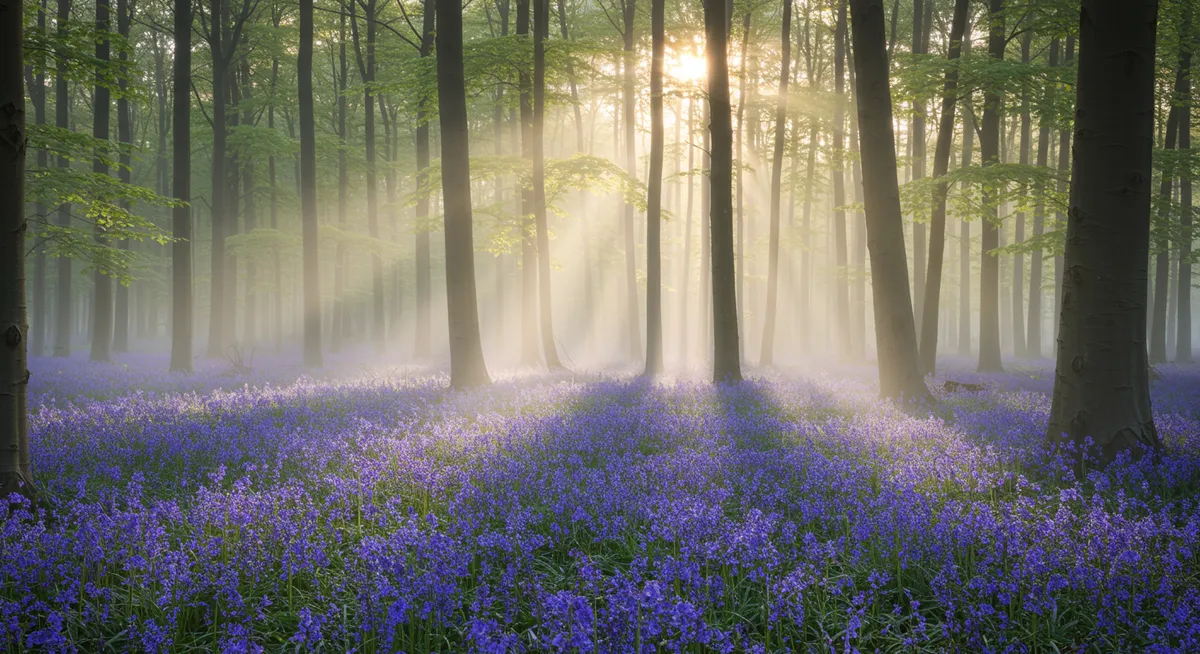Europe's Enchanting Bluebell Woods: Spring's Blue Carpet Phenomenon

Europe's Enchanting Bluebell Woods: Spring's Blue Carpet Phenomenon
For a few precious weeks each spring, ancient woodlands across Europe are transformed into otherworldly landscapes as millions of bluebells burst into bloom. These delicate flowers create stunning violet-blue carpets beneath emerging forest canopies, creating what many consider to be one of Europe's most magical natural spectacles. This guide takes you through the most breathtaking bluebell woodlands and the walking trails that showcase their ephemeral beauty.

The Ecological Significance of Bluebell Woods
Bluebell woods represent far more than just a beautiful spring display—they are living connections to Europe's ancient forest heritage and vital ecosystems:
- Ancient Woodland Indicators: Dense bluebell carpets often indicate forests that have existed continuously for hundreds of years, as these slow-spreading flowers need decades to establish
- Protected Species: The native European bluebell (Hyacinthoides non-scripta) is protected by law in many countries due to habitat loss
- Essential Early Pollinators: Bluebells provide crucial nectar for bees, butterflies, and hoverflies early in the season
- Ancient Forest Continuity: Their presence tells ecologists about the history and health of forest ecosystems
- Cultural Heritage: Bluebell woods feature prominently in European folklore, literature, and cultural identity
Britain's Spectacular Bluebell Walking Trails
Ashridge Estate Ancient Beech Walks, England
The Ashridge Estate in Hertfordshire contains one of Europe's finest examples of ancient beech woodland, with over 1,200 hectares of forest harboring spectacular bluebell displays. The estate's Dockey Wood section offers the most concentrated bluebell experience, where the 3-kilometer Bluebell Walk was specifically designed to showcase the flowers while protecting them.
The best displays typically appear in late April to early May, when sunlight filters through the young beech leaves to illuminate the blue carpet below. The contrast between the fresh lime-green of emerging beech leaves and the intense blue of the flowers creates a color combination that has inspired poets and artists for centuries.
Winkworth Arboretum Bluebell Wood Trail, England
Near Surrey, the Winkworth Arboretum features a dedicated Bluebell Wood Trail that combines spectacular bluebell displays with views over serene lakes. This 2.5-kilometer walking route winds through ancient woodland where native bluebells have flourished undisturbed for centuries.
What makes this trail particularly special is the variety of perspectives it offers, with elevated viewpoints allowing visitors to look across expanses of blue beneath diverse tree species. The trail includes informative signs explaining the ecology and folklore of bluebells, making it both beautiful and educational.
Coed Cefn, Wales
This ancient woodland near Crickhowell in the Brecon Beacons offers one of Wales' most stunning bluebell displays. The circular 4-kilometer walking path through Coed Cefn provides not only magnificent bluebell vistas but also spectacular views over the surrounding Welsh countryside.
What distinguishes this walk is how bluebells here grow alongside traditional Welsh woodland flora, including wood anemones and wild garlic, creating complex tapestries of spring flowers. The woodland's hillside location means that different sections reach peak bloom at slightly different times, extending the optimal viewing period.
Continental Europe's Bluebell Havens
Hallerbos Forest, Belgium
Often called the "Blue Forest," Hallerbos near Brussels offers perhaps the most famous bluebell experience in continental Europe. The forest floor becomes completely transformed by an intense carpet of bluebells each April, with designated walking paths ranging from 1 kilometer to 7 kilometers allowing visitors to immerse themselves in this blue wonderland.
What makes Hallerbos particularly magical is the contrast between the tall, straight trunks of its sequoia trees and the dense blue carpet below. This creates distinctive photographic opportunities with vertical lines cutting through horizontal expanses of color. Since becoming internationally known, Hallerbos has implemented careful visitor management to protect the bluebells while accommodating appreciative crowds.
Bois de Hal, Belgium
Less famous than its neighbor Hallerbos but equally breathtaking, Bois de Hal offers a more secluded bluebell experience with several walking circuits ranging from 3 to 8 kilometers. The forest features ancient oak and beech trees whose twisted forms create a fairytale backdrop for the blue flowers below.
Local conservation efforts have focused on removing invasive species to protect the native bluebells, resulting in increasingly vibrant displays each year. The forest also features historic charcoal production sites where circular clearings allow sunlight to create spotlight effects on the bluebells.
Eifel National Park, Germany
In western Germany, sections of the Eifel National Park transform with bluebells each spring, particularly along the 4-kilometer Blütenpfad (Blossom Path) near Dreiborn. While less concentrated than some British or Belgian sites, the combination of bluebells with the park's unique volcanic landscape creates distinctive scenery.
What makes this walk special is how bluebells here grow alongside wild narcissus and other spring flowers, creating more varied color palettes than purely bluebell-dominated woods. The park's higher elevation means blooms typically appear slightly later than lowland sites, usually peaking in early May.
Hidden Gems: Lesser-Known Bluebell Walks
King's Wood, Kent, England
While less famous than some English bluebell sites, the ancient King's Wood near Ashford offers 6.5 kilometers of trails through spectacular bluebell displays without the crowds of better-known locations. The forest's mixture of ancient coppiced areas and mature trees creates diverse habitat conditions that support particularly healthy bluebell populations.
What makes King's Wood special is the presence of public art sculptures along the trails, creating thought-provoking juxtapositions between natural and created beauty. Local conservation management maintains traditional coppicing practices that have helped bluebells thrive here for centuries.
Kildare Bluebell Trail, Ireland
Ireland's native bluebells create magnificent displays along the 3-kilometer looped trail in County Kildare's Killinthomas Wood. This mixed woodland features ancient oak and ash trees whose high canopies allow perfect light conditions for bluebells to carpet the forest floor.
The trail incorporates historical elements including ancient stone walls and archaeological features that connect visitors to the human history of this landscape alongside its natural beauty. Local volunteer groups maintain the paths and monitor bluebell populations, hosting annual guided walks during peak bloom.
Ranscombe Farm Reserve, England
This nature reserve in Kent offers remarkable bluebell displays across its ancient woodland sections, with circular walks ranging from 2 to 5 kilometers. What makes Ranscombe special is the diversity of spring flowers that accompany the bluebells, including rare species like the lady orchid.
The reserve's combination of woodland and meadow habitats means visitors can experience both bluebell woods and open wildflower meadows in the same walk. Conservation work focuses on connecting fragmented woodland areas to create wildlife corridors, benefiting bluebells and other woodland species.
Timing Your Bluebell Wood Visit
Peak Bloom Windows
Bluebell displays typically reach their peak for just 2-3 weeks each spring, with exact timing varying by location and annual weather conditions. As a general guide:
- Southern England: Mid-April to early May
- Northern England & Wales: Late April to mid-May
- Scotland: Early to late May
- Belgium & Northern France: Mid to late April
- Germany: Late April to mid-May
Weather patterns significantly influence bloom times, with warm early springs accelerating flowering by up to two weeks. Many woodland reserves now operate "bluebell trackers" on their websites, providing real-time updates on bloom progression to help visitors plan optimal timing.
Time of Day Considerations
The visual impact of bluebell woods changes dramatically throughout the day. Early morning offers magical conditions when mist often lingers among the flowers, while mid-morning sun filtering through the canopy brings out the most vibrant blue colors. Late afternoon provides warm golden light that photographers particularly value.
Weekday visits, particularly during working hours, offer the best opportunity to experience bluebell woods in tranquility, as popular sites can become crowded on weekends during peak bloom.

Photography Tips for Bluebell Woods
Capturing the magic of bluebell woods presents unique photographic challenges and opportunities. The contrast between the brilliant blue carpet and the vertical lines of tree trunks creates compelling compositions, particularly in early morning or late afternoon light when shadows add depth.
Consider using a polarizing filter to reduce glare on the bluebells' waxy leaves, bringing out their true color. For intimate portraits of individual flowers or small groupings, a macro lens allows you to capture intricate details like the curled petal tips that distinguish native bluebells from introduced Spanish varieties.
Many photographers recommend shooting from low angles to emphasize the carpet-like effect, while careful use of narrow apertures (high f-numbers) can maintain focus through both foreground bluebells and background trees.
Conservation Challenges and Responsible Visits
Threats to Bluebell Woods
Europe's enchanting bluebell displays face several challenges that threaten their long-term survival:
- Habitat Loss: Ancient woodland continues to be lost to development and agriculture
- Climate Change: Shifting spring temperatures disrupt the delicate timing of bluebell emergence
- Hybridization: Native bluebells are crossing with introduced Spanish bluebells, potentially diluting the distinctive characteristics of native populations
- Visitor Impact: Trampling can damage bulbs and compact soil, affecting future displays
Responsible Bluebell Viewing Practices
When visiting bluebell woods, following these guidelines helps protect these delicate ecosystems:
- Stay strictly on designated paths—even a single footstep can damage bulbs that took years to establish
- Photography should never involve entering the bluebell carpet or rearranging plants
- Keep dogs on leashes and on paths to prevent damage to wider areas
- Never pick bluebells—in many countries, this is illegal as well as damaging
- Consider visiting less-known sites to reduce pressure on famous locations
Cultural Significance of Bluebell Woods
Bluebell woods hold deep cultural significance across Europe, appearing in folklore, literature, and art for centuries. In British folklore, bluebells were said to ring to summon fairies, with warnings that picking them would bring bad luck as they were considered to be under fairy protection.
Writers from Emily Brontë to Beatrix Potter have incorporated bluebell woods into their works, using them to symbolize the fleeting nature of beauty and the mystical qualities of ancient forests. Contemporary artists continue this tradition, with bluebell woods inspiring paintings, photography, and even immersive art installations that attempt to capture their ethereal quality.
Local spring festivals celebrating bluebells take place in many European communities near significant bluebell woods, continuing cultural traditions that connect people to these seasonal natural wonders.
Beyond Bluebells: Companion Spring Flora
While bluebells dominate the visual experience of these spring woodlands, observant walkers will notice many other spring flowers that complement the blue displays. Look for white wood anemones, yellow celandines, and the star-like flowers of wild garlic that often grow alongside bluebells, creating complex tapestries of spring color.
In many woodlands, the bluebell season follows the earlier wood anemone displays and precedes the emergence of brilliant white wild garlic flowers. Understanding this progression allows nature enthusiasts to appreciate the complex choreography of the woodland spring, with each species taking its turn in the spotlight.
Explore More Spring Nature Wonders
Europe's bluebell woods represent just one of spring's spectacular natural displays.
Discover other breathtaking seasonal phenomena in our complete guide to Spring Nature Walks Around the World.